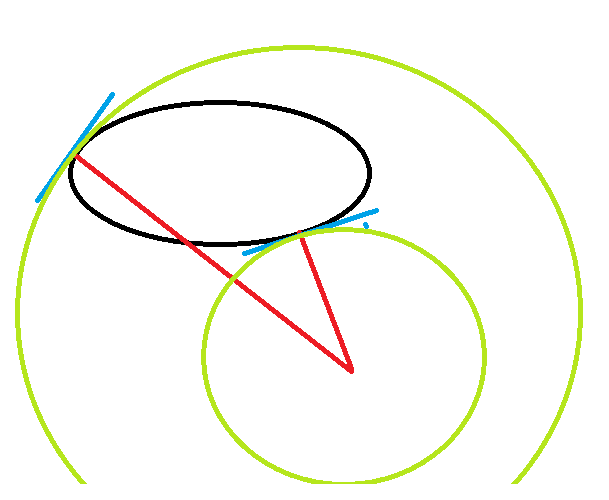When do two ellipses overlap/intersect
See also here
A general rotated ellipse is
Nearest point (x,y).(df/dx, df/dy) = 0. Let this point be (X1,Y1) and (X2,Y2).
Therefore a circle radius between R1 and R2 intersects. A circle of radius >R1 overlaps.
We need to find the relationship between roots of two quadratic simultaneous equations and their coefficients.
It intersects a circle of radius 1/C if (x1^2+y1^2-1/C)(x2^2+y2^1-1/C)<0
or:
(9*e^4+18*d^2*e^2-24*c*e^2+24*a*e^2-96*b*d*e+9*d^4+24*c*d^2-24*a*d^2+16*c^2-32*a*c+64*b^2+16*a^2)*C^2+
(-6*a*e^4+12*b*d*e^3-6*c*d^2*e^2-6*a*d^2*e^2+8*a*c*e^2-16*b^2*e^2-8*a^2*e^2+12*b*d^3*e+16*b*c*d*e+16*a*b*d*e-6*c*d^4-8*c^2*d^2+8*a*c*d^2-16*b^2*d^2)*C
+a^2*e^4-4*a*b*d*e^3+2*a*c*d^2*e^2+4*b^2*d^2*e^2-4*b*c*d^3*e+c^2*d^4 < 0
(which is a 6th degree polynomial)
To convert this to the case where we have two ellipses we need to transform:
a*x^2+2*b*x*y+c*y^2+2*d*x+2*e*y +f = 0
to
X^2 + Y^2 + (a*c*f-b^2*f-a*e^2+2*b*d*e-c*d^2) / ((a*c-b^2)*(a+2*b+c)) = 0
x = X - ((b+c)*sqrt(a*c-b^2)*Y - b*e+c*d)/(a*c-b^2)
y = X + ((a+b)*sqrt(a*c-b^2)*Y - a*e+b*d)/(a*c-b^2)
It is a circle with C^2 = (a*c*f-b^2*f-a*e^2+2*b*d*e-c*d^2) / ((a*c-b^2)*(a+2*b+c))
The matrix S.X = X' is then used to find the new inequality given by K(ST.M.S)<0 This will probably by of order 12!
Ellipses overlap if det( zM-N)=0 has two negative roots. What about INTERSECTING?
A general rotated ellipse is
\(f(x,y) = a x^2+2 b x y+c y^2+d x+e y - 1\)
= X.M.X
= X.M.X
Nearest point (x,y).(df/dx, df/dy) = 0. Let this point be (X1,Y1) and (X2,Y2).
X1^2+Y1^2 = R1^2
Therefore a circle radius between R1 and R2 intersects. A circle of radius >R1 overlaps.
We need to find the relationship between roots of two quadratic simultaneous equations and their coefficients.
It intersects a circle of radius 1/C if (x1^2+y1^2-1/C)(x2^2+y2^1-1/C)<0
or:
(9*e^4+18*d^2*e^2-24*c*e^2+24*a*e^2-96*b*d*e+9*d^4+24*c*d^2-24*a*d^2+16*c^2-32*a*c+64*b^2+16*a^2)*C^2+
(-6*a*e^4+12*b*d*e^3-6*c*d^2*e^2-6*a*d^2*e^2+8*a*c*e^2-16*b^2*e^2-8*a^2*e^2+12*b*d^3*e+16*b*c*d*e+16*a*b*d*e-6*c*d^4-8*c^2*d^2+8*a*c*d^2-16*b^2*d^2)*C
+a^2*e^4-4*a*b*d*e^3+2*a*c*d^2*e^2+4*b^2*d^2*e^2-4*b*c*d^3*e+c^2*d^4 < 0
(which is a 6th degree polynomial)
To convert this to the case where we have two ellipses we need to transform:
a*x^2+2*b*x*y+c*y^2+2*d*x+2*e*y +f = 0
to
X^2 + Y^2 + (a*c*f-b^2*f-a*e^2+2*b*d*e-c*d^2) / ((a*c-b^2)*(a+2*b+c)) = 0
x = X - ((b+c)*sqrt(a*c-b^2)*Y - b*e+c*d)/(a*c-b^2)
y = X + ((a+b)*sqrt(a*c-b^2)*Y - a*e+b*d)/(a*c-b^2)
It is a circle with C^2 = (a*c*f-b^2*f-a*e^2+2*b*d*e-c*d^2) / ((a*c-b^2)*(a+2*b+c))
The matrix S.X = X' is then used to find the new inequality given by K(ST.M.S)<0 This will probably by of order 12!
Ellipses overlap if det( zM-N)=0 has two negative roots. What about INTERSECTING?


Comments
Post a Comment